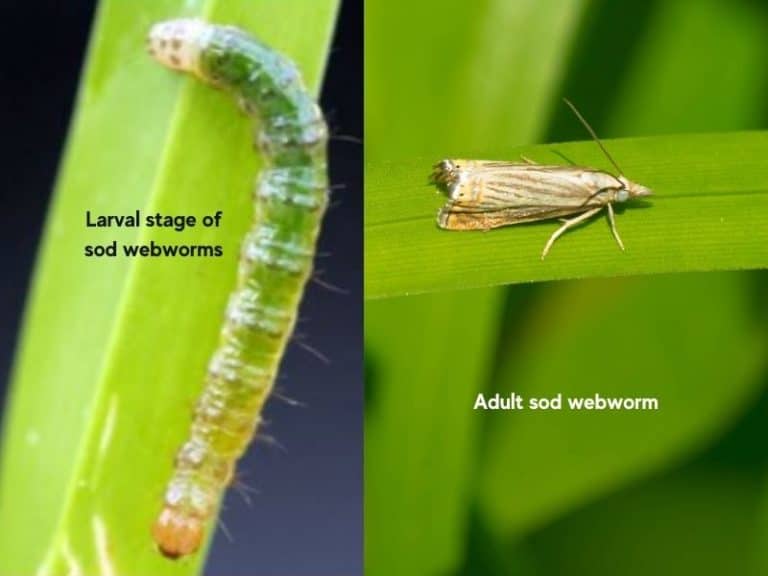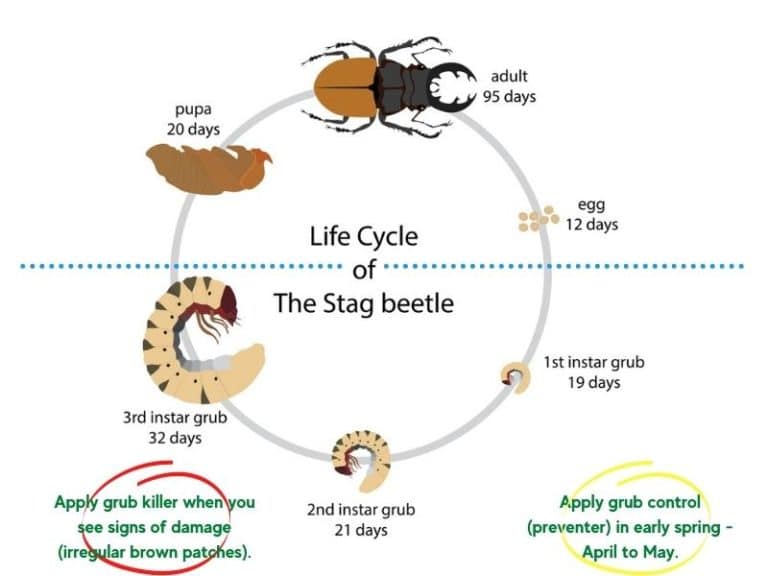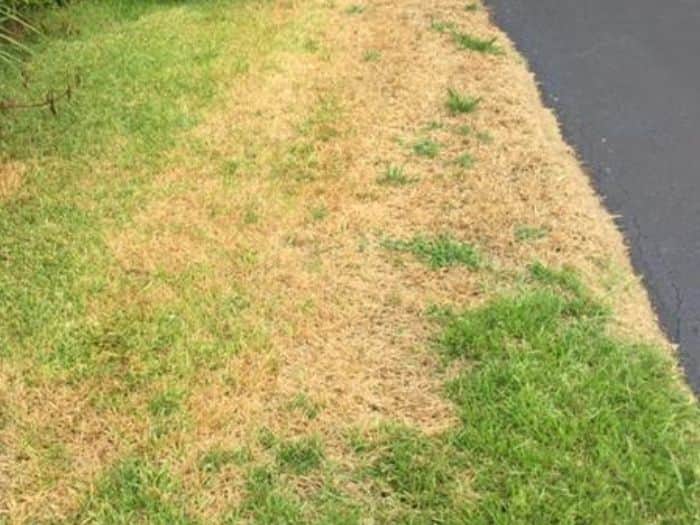Can I Apply GrubEx to a Wet Lawn and Before Rain?
Grubs eat and cut the roots of the grass in lawns, leaving ugly brown patches of grass during late summer or early fall when their activity intensifies. While GrubEx is one of the best grub control pesticides on the market today, you want to ensure you apply it the right way to work as expected. So then, can you apply Scotts GrubEx to a wet lawn?
You can safely apply GrubEx to a wet lawn that doesn’t have stagnant water. Ensure you water it for 30 minutes to activate the pesticide. You can also apply GrubEx just before rain in late spring or early summer and let the rainwater activate and move it into the root zone to kill grubs.
Table of Contents
Can I apply GrubEx to a wet lawn?
According to the Scotts GrubEx label, you can apply GrubEx to a wet lawn, but for optimum effectiveness, apply the pesticide when the lawn is dry, then water it into the soil. Grub Ex will wash down into your soil and disrupt the life cycle of the grubs before they hatch and mature.
Can I apply GrubEx before the rain?
You can apply GrubEx just before it rains, but you won’t need to water it as you normally would when applying the granules. Waiting for rain works best for lawns that are too big to water. You only need to ensure that you apply GrubEx any time between May and July. This protects your lawn from the next generation of grubs that appear during late summer.
Caution: Watering in GrubEx after the application is the safest option rather than waiting for rain. Sometimes rain in two days is a prediction that won’t happen. Grub Ex does not work in hot and dry conditions. If GrubEx is not watered in after application, it will be ineffective and you will still have a Grub problem.
When is the best time to apply GrubEx?
The best time to apply GrubEx is during spring to early summer (May or June), when the beetles lay eggs on your turf. GrubEx works as a preventive measure by killing grubs as they hatch. As such, a single application will kill grub types before they are big enough to damage your lawn or new sod and prevent infestation for the whole season.
Applying GrubEx in May protects your lawn from grubs that hatch and feed on the grass in late summer. A May and June application gives you the highest Grub control. Ensure the soil is not saturated with water, and remember to water after application.
GrubEx does not kill mature grubs but gets the grub population down by killing them as they hatch( before going to the next life cycle stage).
Here’s how the grub cycle takes place:
- Early spring– Mature grubs wake up from hibernation and travel from the deep soil to just beneath the grass surface. Grubs then turn to their pupa stage in late spring before changing into beetles that eat roses, trees, and shrubs.
- Summer– The beetles tunnel into your turf and lay eggs that will develop or hatch into grubs.
- Late summer and early fall– Grubs do the most damage during late summer and early fall by feeding excessively on your turf’s roots to prepare for winter hibernation.
When is it too late to treat grubs?
It is too late to treat grubs using GrubEx late summer and early spring because they will mature or be at an advanced larval stage. GrubEx does not kill mature grubs but works to eliminate the beetle’s eggs as they hatch.
During late summer and early fall, the grubs are already mature and feed on your turf to get ready for hibernation. GrubEx will also not work on grubs during early spring as they are getting ready to go to the pupae stage and shift into beetles.
You can only apply a control measure to kill mature grubs during late summer, fall, or early spring. GrubEx will not work, but you can eliminate them in your lawn with curative control materials that provide 24-hour grub control.
How many times can you apply GrubEx?
One application between April and mid-summer is enough to kill the next generation of grubs that mature and feed on turf roots during late summer and early fall. However, you can apply Scotts GrubEx twice between April and Mid Summer if:
- You believe that the GrubEx granules were not watered after application.
- The GrubEx granules were applied to a turf area that has stagnant water (super saturated soils).
- You have a huge grub problem on your lawn.
Applying GrubEx will kill various grub species, including Japanese beetles, white grubs, Asiatic Garden beetles, Black turfgrass Genus Ataenius, green June beetles, northern masked beetles, and Oriental beetles. It also kills insects like armyworms, sod webworms, billbug grubs, and crane fly larvae.
How to apply GrubEx on your lawn?
Apply Grub Ex with a rotary or drop spreader evenly over your lawn (2.87 lbs per 1000 square feet.). Follow up by watering your turf for 30 minutes to activate GrubEx. About 0.5 inches of water is required to move the chemical into the root zone.
Sweep the product from hard surfaces like the driveways and sidewalks near the lawn to prevent water from washing it off into water bodies or drainage ditches nearby. Always read the product label before use for safe handling. Safety data sheets can be very informative for Grubex use and effectiveness on your lawn.
Annual application is recommended as a preventative measure that does prevent eggs from maturing and hatching. Apply it late in the spring and it will remain in the soil through mid-summer or for about four months.
Precautions to take when using GrubEx
GrubEx poses a health risk to humans and pets when not used as directed by the manufacturer. Here are precautions to remember while using GrubEx:
- Wait till the lawn is dry after the GrubEx application to let your kids and pets play on the turf.
- Once you finish the application, discard or wash contaminated clothing before reusing it.
- Use GrubEx on lawns only and not on houseplants or vegetable gardens.
- Do not use GrubEx if you live within 100 feet of a water body like a lake, pond, or river in New York (the law prohibits it). If you must, create a barrier that prevents GrubEx from penetrating these water bodies or drainage ditches.
Note: GrubEx kills grubs and spares earthworms, bees, and other types of wildlife.
How to take care of lawn after using GrubEx?
After successfully treating your lawn, apply the following lawn care tips to prevent it from becoming vulnerable to future grub infestation:
- Use fertilizing supplements– Choose a fertilizer supplement that works with the type of grass on your lawn. The right supplements will make your lawn denser and withstand harsh environmental conditions, human and animal activities, and weeds.
- Mow your lawn weekly– Mowing allows the roots to absorb water effectively and grow into a deep root system.
- Retain the pruned or mowed grass – Your lawn uses the mowed or pruned grass as mulch, which adds nutrients to the soil.
- Water your lawn 2 times per week– Ensure your lawn is properly hydrated, particularly when the weather is hot and dry. You’ll know your grass is thirsty if its blades look wilted or change color. Use a sprinkler to irrigate your lawn if there’s no rain.
Can I apply GrubEx to a wet lawn?
Ideally, GrubEx should be applied on a dry lawn where rain is not expected for at least 24 to 48 hours. However, you can apply grubex on a wet lawn but avoid lawns with stagnant, puddles, or standing water. Excessive water can hinder proper absorption and its effectiveness. Monitor the weather conditions and adjust the application rate slightly to cater to potential moisture dilution. Read the product label for specific instructions on adjusting the application rate. Use a spreader or sprayer to ensure uniform coverage and help distribute the product effectively.
How long does GrubEx last?
The GrubEx formulation contains the active ingredient imidacloprid, which typically provides a control for about 3 to 4 months. This means that it can protect your lawn from grubs for that duration after the application although it may provide preventive measures for more depending on the types of grubs and other factors such as rainfall, excessive irrigation, or certain soil conditions can impact the product’s performance. In many cases, the yearly application will serve the purpose unless under extreme gruds infestation.
How late is too late for grub control?
The rule of thumb is to apply grub control products before or during the peak egg-laying period of adult beetles. Mostly this usually occurs in late spring or early summer though it may vary depending on the specific beetle species and the region you’re in. Therefore, I recommend you consult with local experts, extension offices, or lawn care professionals to determine the most appropriate timing for grub control in your area for this method’s timely application and effectiveness.
Can grubex kill grass?
GrubEx primarily targets and controls grubs, the larvae of certain beetles, and is designed to minimize potential damage to the grass. Following recommended instructions is key since excessive application can damage your turfgrass. In addition, some grass lawns may be sensitive to some chemicals found in grubex. In addition, proper lawn care practices, like regular watering, mowing at the appropriate height, and adequate fertilization, would help maintain a healthy and resilient lawn to handle potential stressors like GrubEx.
What is the best month to put down grub control?
Applying grub controls is best done in late spring to early summer(between May and July). During this period, adult beetles, such as Japanese beetles or June bugs, lay their eggs in the soil. The eggs hatch into grubs, and these young grubs feed on grassroots during the summer months. Applying grub control products before or during this egg-laying and hatching period is crucial to prevent the grubs from causing damage to your lawn.
What temperature can you apply GrubEx?
Apply GrubEx when the soil temperature reaches around 55 to 60 degrees Fahrenheit (12 to 15 degrees Celsius). The grubs are more active at this temperature and start feeding on the grassroots when the soil temperature reaches a certain threshold. Applying GrubEx before this point helps to target the grubs at their most vulnerable stage and prevent damage to your lawn.
References
- The United States Environmental Protection Agency: Scotts GrubEx 2 Season Long Grub Killer Label


![How Do You Get Rid of Ants in Grass [Fixes that Work]](https://lawnmodel.com/wp-content/uploads/2020/10/How-to-get-rid-of-ants-in-grass-768x512.jpg)


